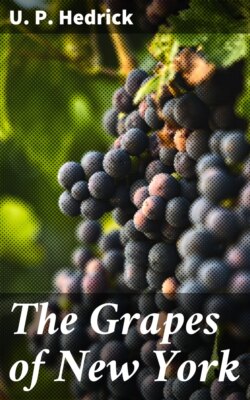Читать книгу The Grapes of New York - U. P. Hedrick - Страница 48
VITIS AESTIVALIS LINCECUMII[145] Munson.
Оглавление1. (?) Rafinesque, 1830:9. V. Multiloba; Dissected vine. 2. (?) Prince, 1830:183. V. diversifolia. 3. U. S. Pat. Off. Rpt., 1847:199. Post oak grape. 4. Buckley, Ib., 1861:485. V. Linsecomii; Post-oak grape; Pine-wood grape. 5. Ib., Proc. Phil. Acad. Nat. Sci., 1861:450. V. Linsecomii. 6. Engelmann, Mo. Ent. Rpt., 1874:74. 7. Ib., Bush. Cat., 1883:16, 23. Post-oak grape. 8. Munson, Am. Hort. Soc. Rpt., 1885:135. V. Lincecumii; Post-oak. 9. Planchon, De Candolle’s Mon. Phan. 5:323, 338. 1887. V. Lincecumii; Post-oak grape; Vine Wood grape; V. aestivalis, var. Lincecumii; V. incisifolia; V. multiloba? 10. Munson, U. S. D. A. Pom. Bul., 3:12. 1890. V. Lincecumii. 11. Ib., Gar. and For., 3:474. 1890. V. Lincecumii. 12. Ib., Am. Gard., 12:585. 1891. V. Lincecumii; Post-oak grape. 13. Ib., Mich. Hort. Soc. Rpt., 1893:116. V. Lincecumii; Post Oak grape. 14. McCluer, Ill. Sta. Bul., 28:257. 1893. V. Lincecumii; Post-oak grape. 15. Munson, Bush. Cat., 1894:20, 22, 27. fig. V. Lincecumii; Texas Post-oak grape. 16. Husmann, 1895:110. V. Lincecumii; Summer grape; Post Oak grape. 17. Munson, Rural N. Y., 56:610. 1897. V. Lincecumii; Post-oak grape. 18. Mo. Sta. Bul., 46:62. 1899. V. Lincecumii; Texas Post Oak grape. 19. Munson, Tex. Sta. Bul., 56:218, 231, 234, 235, 240, 261, 264. 1900. fig. V. Lincecumii; Post-oak grape. 20. Bailey, Cyc. Am. Hort., 4:1954. 1902. V. diversifolia; Post-oak; Pine-wood; Turkey grape. 21. Viala and Ravaz, Am. Vines, 1903:42, 57. V. Lincecumii; Post Oak.
Vine vigorous, sometimes climbing high upon trees, sometimes forming a bushy clump from two to six feet high; canes cylindrical, much rusty wool on shoots; tendrils intermittent. Leaves very large, almost as wide as long; entire or three-, five-, or rarely seven-lobed; lobes frequently divided; sinuses, including petiolar sinus, deep; smooth above, and with more or less rusty pubescence below. (The north-Texas, southwestern Missouri and northern Arkansas form shows little or no pubescence but has fine prickly spines at base of shoots and shows much blue bloom on shoots, canes and the under side of the leaves.) Fruit small to large, usually larger than typical Aestivalis, usually black with heavy bloom. Seeds larger than Aestivalis, pear-shaped; chalaza roundish.
Lincecumii seems to have been first described by Rafinesque, in 1830 under the name Vitis multiloba. His description fits fairly well, and as the source from which the vines were secured is within the habitat of the species, there appears but little doubt as to its correctness. In the same year Prince gives a very brief description of a grape from Texas under the name Vitis diversifolia which is probably this grape. The first description of the variety (or species) in such detail that it could not be mistaken was that of Buckley in 1861, as Vitis linsecomii.
It inhabits the eastern half of Texas, western Louisiana, Indian Territory, Arkansas and southern Missouri on high sandy land, frequently climbing post-oak trees, hence the name, Post-oak grape, by which it is locally known.
Lincecumii has attracted considerable attention through the work of H. Jaeger and T. V. Munson in domesticating it, both of whom considered it one of the most, if not the most, promising form from which to secure cultivated varieties for the Southwest. The qualities which recommended it to them are: First, its vigor; second, its capacity to withstand rot and mildew; third, its hardiness and capacity to endure hot and dry summers without injury; and fourth, the large cluster and berry which were found on certain of the wild vines. It requires a longer season to mature than that of New York and is, consequently, of but little interest to grape-growers in this State. The fruit is characteristic because of its dense bloom, firm, yet tender texture and the peculiar so-called Post-oak flavor. The cultivated varieties have given satisfaction in many sections of the central western and southern states. Like Aestivalis, it is difficult to propagate from cuttings.
The north-Texas glaucous form of this variety mentioned in the technical description above is the Vitis aestivalis glauca of Bailey. This is the type of Lincecumii that Munson has used in his breeding work.
